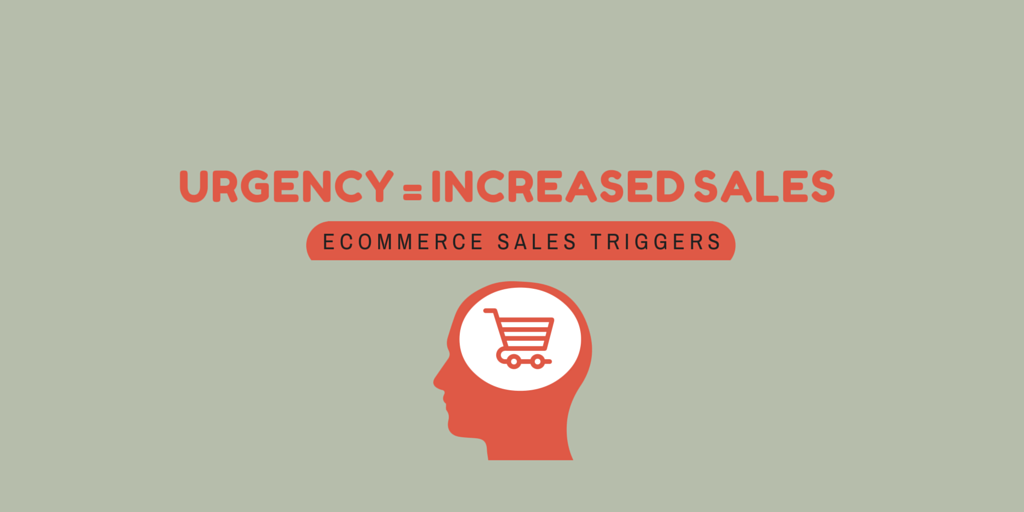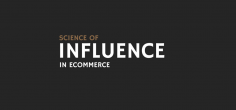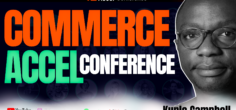
5 Ways of Using the URGENCY Psychology Trigger to Drive More eCommerce Sales
Urgency is quite a powerful psychological tool to encourage and trigger purchase. Urgency is also a key way of overcoming sales objections. Building it into sales pitches is marketing and salesmanship 101. Building it into sales is almost the point of a sale – just look at the recent furore over Black Friday and Cyber Monday, with their limited-time-only sales triggering scenes of customers stay up all night in queues to get in first and grab those bargains quick.
If you manage an ecommerce site, how can you leverage the power of urgency to create more sales in your store?
1. Scarcity: Restrict Unit Availability
This is one way of creating that ‘get it before it’s gone!’ feeling that drives urgency. Emphasizing the finite availability of units of a product in an open market reminds buyers that,just like them, other buyers are eying up the same product. Sites that display a product along with a unit counter showing how many are left include good old eBay, along with Amazon. Here are few examples:
Amazon
Amazon warns when there are few items left and makes an even more urgent appeal when only one remains.

Barker & Stonehouse
Barker & Stonehouse display stock availability in numbers and colour codes. Items with less that 6 units in stock are coloured orange and products with 6 or more units in stock are labelled ‘6+ in stock’ and coloured green.

Miss Selfridge
Miss Selfridge take it a bit more granularly by tagging items that a low in stock on a size by size basis.

House of Fraser
Just like Miss Selfridge, House of Fraser indicate when items are running out of stock with a call to action: ‘Hurry’.

Groupon
Another e-tailer that builds its whole approach on restricted availability is group buying site: Groupon. They don’t even stock physical products – yet they achieve scarcity in other ways, by restricting the number of people who can opt in for a given deal.

In all of the five examples above, urgency is an excellent passive driver: you simply display the number of units left and let it take its effects in creating perceived scarcity and driving up both the perceived value of the product and urgency. People who need or are deliberating on buying the product are more compelled to purchase the it before it goes out of stock!
2: Restricting Access with Flash Sales and Invite Only Deals
The equation is simple: number of potential buyers divided by number of products. If only you and three other people in the world might possibly want to buy a thing and you know where you can get four of it, you can afford to sit back. If the number of potential buyers is significantly high and there is limited availability of the product, then you have scarcity that creates urgency.
But really, it doesn’t matter how many units exist – it matters how many units you can access. And restricting access is another great way to generate urgency.
This is where organising invite-only events come into play: flash sales are a highly effective way of doing this.
Amazon’s MyHabit
Did you know that Amazon has it’s membership-only flash fashion website – MyHabit.com.

Flash sales are an increasingly popular method of marketing, expanding a store and retail brand as a whole – as it is likely to spur a word-of-mouth effect.
Flash Sales for Magento Commerce Merchants
So don’t think Flash Sales are the preserve of only enterprise players like Amazon, Zulily and Idelli. Magento commerce driven stores are able to install extensions such as Private Sales / Flash Sales (by Boost Shop) and Private Sales (by Plumrocket) that will enable the set up of a private VIP area in your store for flash sales.

3: Time Limited Sales Price
This is an all too familiar concept from grocery shopping. Seasonal or event-focused sales are attached to an event on the one hand and carry a time limit on the other, are a great way to introduce urgency into the equation – think of back-to-school sales, for instance.
Rather than looking at the event anchor, though we can look at the time limit, which can be arbitrary or designed to suit strategic needs. Sales of any sort have the advantage that they’re an event in themselves that can be publicised as such.
Abercrombie & Fitch
Here’s US clothing brand Abercrombie & Fitch:

Tesco Clothing
Tesco clothing are offering an ‘exclusive 25% discount’ to a selection of their products with fixed time limit i.e. 23:59 GMT Sunday 15th February 2015

John Lewis
John Lewis are offering £30 cash back to customers that trade in their old washing machines when they purchase this model from them with a time limit.

Naked Wines
Naked Wines have time limited sales integrated with their brilliant emails. This example has a countdown timer.

4: Bundled Offers
Bundled offers are an urgency trigger that essentially involves nudging up shoppers to add more products to a purchase at a significant discount. You can sell and up-sell simultaneously, baiting the sale with more desirable products and at the same time offer a cut price for the bundle.
Alternatively you can cross-sell here too. The ’yours for just £X when you buy Y’ – a core bundle offer that is a familiar sight, because it works.
Link these offers to a time limit to drive urgency and increase both sales and average order value.
7DayShop
7DayShop offer a ‘GOOD TO GO’ rechargeable battery bundle, in which they sell 3 packs of AA and AAA batteries at a significant discount.

Ocado
Ocado offer a ‘Bundles Offers’ category. They are offering a 25% discount in this bundle.

SLRHut
Photography retailers probably make the most use of bundling as a psychological trigger to boost sales. Here is an example from SLRHut.

5: Shipping Offers
Express shipping offers are usually time limited – buy before a certain time, or in a canny twist, a display of the time remaining to take advantage of the offer, slowly counting down (the method Amazon uses).

Some stores use a dual countdown – before the clock runs down to receive the product by Friday. Why does this work so well? The same reason you’d prefer to save £50 to 10% off, and either to ‘a discount.’ Make it concrete and you make it real.
Some shipping offers are order size dependent (i.e. free shipping for orders over £50) and are really bundle offers. Either way, the price of the product isn’t affected, but the overall price of the purchase is. The variable is shipping cost – and online consumers love a deal on shipping.
As a rule, people will tend to reach for items that are either scarce or described as being ‘premium’ – which is to say that express shipping is ‘good,’ to most people, even if they don’t really need the item all that quickly.
5 Ways of Using the URGENCY Psychology Trigger to Drive More eCommerce Sales
Urgency is quite a powerful psychological tool to encourage and trigger purchase. Urgency is also a key way of overcoming sales objections. Building it into sales pitches is marketing and salesmanship 101. Building it into sales is almost the point of a sale – just look at the recent furore over Black Friday and Cyber Monday, with their limited-time-only sales triggering scenes of customers stay up all night in queues to get in first and grab those bargains quick.
If you manage an ecommerce site, how can you leverage the power of urgency to create more sales in your store?
1. Scarcity: Restrict Unit Availability
This is one way of creating that ‘get it before it’s gone!’ feeling that drives urgency. Emphasizing the finite availability of units of a product in an open market reminds buyers that,just like them, other buyers are eying up the same product. Sites that display a product along with a unit counter showing how many are left include good old eBay, along with Amazon. Here are few examples:
Amazon
Amazon warns when there are few items left and makes an even more urgent appeal when only one remains.

Barker & Stonehouse
Barker & Stonehouse display stock availability in numbers and colour codes. Items with less that 6 units in stock are coloured orange and products with 6 or more units in stock are labelled ‘6+ in stock’ and coloured green.

Miss Selfridge
Miss Selfridge take it a bit more granularly by tagging items that a low in stock on a size by size basis.

House of Fraser
Just like Miss Selfridge, House of Fraser indicate when items are running out of stock with a call to action: ‘Hurry’.

Groupon
Another e-tailer that builds its whole approach on restricted availability is group buying site: Groupon. They don’t even stock physical products – yet they achieve scarcity in other ways, by restricting the number of people who can opt in for a given deal.

In all of the five examples above, urgency is an excellent passive driver: you simply display the number of units left and let it take its effects in creating perceived scarcity and driving up both the perceived value of the product and urgency. People who need or are deliberating on buying the product are more compelled to purchase the it before it goes out of stock!
2: Restricting Access with Flash Sales and Invite Only Deals
The equation is simple: number of potential buyers divided by number of products. If only you and three other people in the world might possibly want to buy a thing and you know where you can get four of it, you can afford to sit back. If the number of potential buyers is significantly high and there is limited availability of the product, then you have scarcity that creates urgency.
But really, it doesn’t matter how many units exist – it matters how many units you can access. And restricting access is another great way to generate urgency.
This is where organising invite-only events come into play: flash sales are a highly effective way of doing this.
Amazon’s MyHabit
Did you know that Amazon has it’s membership-only flash fashion website – MyHabit.com.

Flash sales are an increasingly popular method of marketing, expanding a store and retail brand as a whole – as it is likely to spur a word-of-mouth effect.
Flash Sales for Magento Commerce Merchants
So don’t think Flash Sales are the preserve of only enterprise players like Amazon, Zulily and Idelli. Magento commerce driven stores are able to install extensions such as Private Sales / Flash Sales (by Boost Shop) and Private Sales (by Plumrocket) that will enable the set up of a private VIP area in your store for flash sales.

3: Time Limited Sales Price
This is an all too familiar concept from grocery shopping. Seasonal or event-focused sales are attached to an event on the one hand and carry a time limit on the other, are a great way to introduce urgency into the equation – think of back-to-school sales, for instance.
Rather than looking at the event anchor, though we can look at the time limit, which can be arbitrary or designed to suit strategic needs. Sales of any sort have the advantage that they’re an event in themselves that can be publicised as such.
Abercrombie & Fitch
Here’s US clothing brand Abercrombie & Fitch:

Tesco Clothing
Tesco clothing are offering an ‘exclusive 25% discount’ to a selection of their products with fixed time limit i.e. 23:59 GMT Sunday 15th February 2015

John Lewis
John Lewis are offering £30 cash back to customers that trade in their old washing machines when they purchase this model from them with a time limit.

Naked Wines
Naked Wines have time limited sales integrated with their brilliant emails. This example has a countdown timer.

4: Bundled Offers
Bundled offers are an urgency trigger that essentially involves nudging up shoppers to add more products to a purchase at a significant discount. You can sell and up-sell simultaneously, baiting the sale with more desirable products and at the same time offer a cut price for the bundle.
Alternatively you can cross-sell here too. The ’yours for just £X when you buy Y’ – a core bundle offer that is a familiar sight, because it works.
Link these offers to a time limit to drive urgency and increase both sales and average order value.
7DayShop
7DayShop offer a ‘GOOD TO GO’ rechargeable battery bundle, in which they sell 3 packs of AA and AAA batteries at a significant discount.

Ocado
Ocado offer a ‘Bundles Offers’ category. They are offering a 25% discount in this bundle.

SLRHut
Photography retailers probably make the most use of bundling as a psychological trigger to boost sales. Here is an example from SLRHut.

5: Shipping Offers
Express shipping offers are usually time limited – buy before a certain time, or in a canny twist, a display of the time remaining to take advantage of the offer, slowly counting down (the method Amazon uses).

Some stores use a dual countdown – before the clock runs down to receive the product by Friday. Why does this work so well? The same reason you’d prefer to save £50 to 10% off, and either to ‘a discount.’ Make it concrete and you make it real.
Some shipping offers are order size dependent (i.e. free shipping for orders over £50) and are really bundle offers. Either way, the price of the product isn’t affected, but the overall price of the purchase is. The variable is shipping cost – and online consumers love a deal on shipping.
As a rule, people will tend to reach for items that are either scarce or described as being ‘premium’ – which is to say that express shipping is ‘good,’ to most people, even if they don’t really need the item all that quickly.






